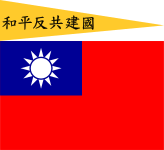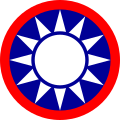Reorganized Government of the Republic of China
| 中華民國 | |||||
|
Zhōnghuá Mínguó |
|||||
| Republic of China | |||||
| 1940-1945 | |||||
|
|||||
|
Motto : Chinese 和平,反共,建國 ( Peace, Anti-Communism , National Foundation ) |
|||||
| Official language | Chinese | ||||
| Capital | Nanjing | ||||
| Form of government | republic | ||||
| Head of government |
Wang Jingwei (1940–1944), Chen Gongbo (1944–1945) |
||||
| currency | Chinese yuan | ||||
| founding | March 30, 1940 | ||||
| resolution | August 16, 1945 | ||||
| National anthem | San Min Chu-i | ||||
| The Reorganized Government of the Republic of China in the Empire | |||||
The Reorganized Government of the Republic of China , officially the Republic of China ( Chinese 中華民國 , Pinyin Zhōnghuá Mínguó ) was a pro-Japanese puppet government and existed from 1940 to 1945 during the Second Sino-Japanese War . The government founded by the Japanese occupation forces in China and chaired by Wang Jingwei faced the national Chinese government of Chiang Kai-shek in Chongqing , which fought against the Japanese army . The government resided in the Japanese occupied Nanjing , which is why they sometimes regime of Nanjing , Nanjing government , national government in Nanjing ( 南京國民政府 / 南京国民政府 , Nanjing Guo Mín Zhèngfǔ ) or Republic of China-Nanjing is called. It is also known as the Wang Jingweis government ( 汪精衛 政權 / 汪精卫 政权 , Wāng Jīngwèi Zhèngquán ).
founding
After their attack in 1937, the Japanese founded several collaborative governments to administer the occupied countries, including the Provisional Government of the Republic of China in Beijing and the Reformed Government of the Republic of China in Nanjing .
Wang Jingwei was a former prime minister of the Republic of China and former chairman of the Guomindang who was overthrown by his adversary Chiang Kai-shek . His collaboration with the Japanese resulted in the latter enjoying the approval of a prominent political figure. The new republic was founded by the unification of various governments, with the exception of the Manshu Empire , which was recognized as an independent state.
Wang Jingwei's government pretended to be the legitimate government of China with the aim of taking power over all of China from the Chongqing government. As a disciple of Guomindang founder Sun Yat-sen , Wang Jingwei and his government used the Guomindang flag and insignia, as well as the same name as the government under Chiang Kai-shek's leadership.
The government was established in March 1940, with Liang Hongzhi , Chairman of the Reformed Government of the Republic of China, Wang Jingwei stepping down. Zhou Fohai , who held the posts of Finance and Foreign Minister and Mayor of Shanghai , was appointed Deputy Prime Minister . In theory, the government administered all of China, including Mengjiang , a collaborative unit in Inner Mongolia that remained relatively independent. In reality, the government controlled Jiangsu , Anhui, and northern Zhejiang provinces .
During the Japanese offensive in 1941, its administrative area extended to the provinces of Hunan , Hubei and parts of Jiangxi . The Shandong and Hebei Provinces were theoretically administered by the national government in Nanjing, but in reality the commander of the Japanese Northern Front ruled over the country. In 1940, the area of the national government administered area in Nanjing was 1,264,000 km².

In July 1941, the government of the German Reich recognized the regime as the only legitimate government in China. The German Reich then cut ties with the Guomindang government .
According to its good relations with the collaborating government, Japan gave it the international concessions in Shanghai in July 1943.
Participation in the war
The national government troops in Nanjing were equipped with Japanese planes and tanks . The navy consisted mainly of captured American and Chinese warships. According to a British estimate, the army comprised around 345,000 men in 1943. The collaboration forces fought the guerrillas of the communists from the New Fourth Army .

The national government had its own intelligence service named after his address: Jessfield 76 .
The government declared war on Britain and the United States on January 9, 1943. In November 1943, Wang Jingwei represented China at the Greater East Asia Conference in Tōkyō . After Wang Jingwei's death, Chen Gongbo became the new head of state.
collapse
The pro-Japanese puppet government collapsed in mid-August 1945 after Japanese troops in China had to surrender to the Guomindang army. Chen Gongbo and Liang Hongzhi were executed in 1946 . Zhou Fohai died in prison in 1948.
Important personalities
- Wang Jingwei , head of state (1940–1944)
- Chen Gongbo , Head of State (1944–1945), Mayor of Shanghai (1940–1944)
- Zhou Fohai , Minister of Finance (1940–1945), Mayor of Shanghai (1944–1945)
- Li Shiqun , chief of Jessfield 76 (1940–1943)
- Lin Bosheng , Minister of Propaganda (1940–1944)
- Zhao Zunyue , Minister of Propaganda (1944–1945)
- Xiao Shuxuan , Chairman of the Military Council (1942–1945)
- Bao Wenyue , Minister of Defense (1940-1943)
- Ye Peng , Minister of Defense (1943-1945)
- Yang Kuiyi , Chief of the General Staff (1940–1942)
- Ren Yuandao , Minister of the Navy (1942–1945)
- Chu Minyi , Foreign Minister (1941–1944), Ambassador to the Japanese Empire (1940–1941)
- Chen Qun , Home Secretary (1940-1943), Chairman of the Examination Yuan (1944-1945)
- Mei Siping , Minister of the Interior (1943–1945)
- Jiang Kanghu , Chairman of the Examination Yuan (1942-1944)
- Abe Nobuyuki , Special Envoy of Japan (April 1940)
- Chen Jicheng , ambassador of the national government in the Manshu Empire (1943–1945)
- Honda Kumatarō , Japanese Ambassador (1940-1943)
- Heinrich Georg Stahmer , German Ambassador (1942)
- Ernst Woermann , German Ambassador (1943–1945)
See also
- Greater East Asian Prosperity Sphere
- Manchukuo (Manshu Empire)
- Azad Hind (Provisional Government of Free India)
literature
- Mechthild Leutner (Ed.): Germany and China 1937–1945. Politics - military - economy - culture. A collection of sources (= sources on the history of German-Chinese relations from 1897 to 1995. 4). Akademie-Verlag, Berlin 1998, ISBN 3-05-002986-2 .
- David P. Barrett, Larry N. Shyu (Eds.): Chinese Collaboration with Japan, 1932-1945. The Limits of Accommodation. Stanford University Press, Stanford CA 2001, ISBN 0-8047-3768-1 .
- John Hunter Boyle: China and Japan at War, 1937-1945: The Politics of Collaboration Stanford University Press, Stanford CA 1972, ISBN 0-8047-0800-2 .
- Gerald E. Bunker: The Peace Conspiracy. Wang Ching-wei and the China War, 1937-1941 (= Harvard East Asian Series. 67, ISSN 0073-0491 ). Harvard University Press, Cambridge MA 1972.



